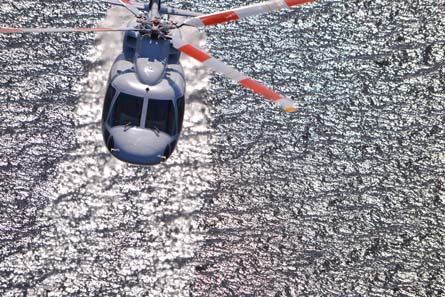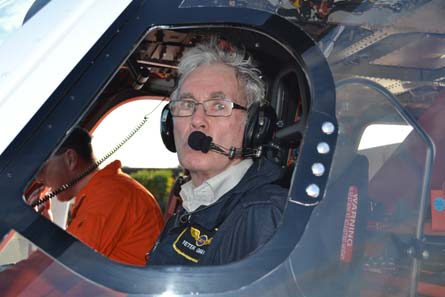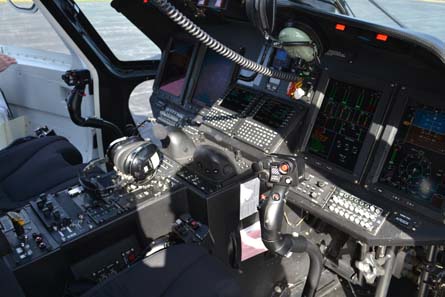Although Sikorsky's newest twin is called an S-76 and looks the same as the previous models, the "D" model is in a category of its own.
The cockpit has been redesigned with pilot and customer input, safety features have been added, the main and tail rotors made afresh and the engines upgraded to the more powerful and fuel-efficient Pratt and Whitney PW210S. This burned about 600lb/h on our 8 December test flight. Sikorsky experimental test pilot Greg Barnes, in command for the test flight, says this is typical. With a maximum fuel capacity of 1,900lb, a flight of nearly 3h with adequate reserves is now possible. The PW210S engines will allow the Category A take-offs from rooftops, which VIP customers like. In big cities it is often quicker to go to the office by helicopter than by road. The main and tail rotors are of modern design and made of composite materials on the D model, and will have de-ice capability as an extra option.
 |
|---|
| © John Croft/Flightglobal |
Included now among standard equipment are an updated Helicopter Utilisation Monitoring System (HUMS), Enhanced Ground Proximity Warning System (EGPWS), Traffic Collision Advisory System (TCAS), active vibration control system and integrated digital map. Operators can send their HUMS data to Sikorsky, which analyses it. As well as prior warning that a component is suspect, this can also lead to increased component lives and modified maintenance schedules, thus reducing direct operating costs. The HUMS also monitors the main rotor track and balance. The results are downloaded and any correction described.
HIGH ALTITUDE
As with any new product, there is a built-in upgrade capability, such as an increased maximum take-off weight, higher never-exceed velocity (VNE), especially for high-altitude operations. The present certified ceiling is 15,000ft. Although Sikorsky reckons that the S-76D will perform adequately at 20,000ft, there are no plans to certify the helicopter above 15,000ft. The engines are certified to 20,000ft, which will be comforting to pilots when operating at high altitude.
Sadly, the helicopter industry accident rate is still excessive and lags that of commercial fixed-wing operations. But the industry is trying to catch up and improve it, as evidenced by the wealth of proactive and reactive safety devices on the S-76D. All seats will be crash attenuating and have upper body restraints. The cockpit voice recorder (CVR) is a standard fit and there is ample built-in redundancy. For example, there are two full-authority digital engine controls (FADECs) that monitor each other, eliminating the provision of manual throttles. There are also dual autopilots that monitor each other, meaning that a system failure will automatically disconnect it with no action required by the pilot. The warning system will show the pilot what has happened.
The test aircraft carried out an immaculate coupled, hands-off instrument landing system approach to the hover over the runway - fixed-wing pilots will be green with envy. The production aircraft will be able to be landed virtually hands off. Ours was taken down automatically to a high hover using the velocity and radar altitude holds, then lowered to about 1ft using just one button. Sikorsky has built more than 800 S-76 models, which have accumulated more than 5.6 million hours of flight time. It has also incorporated many features from its successful S-92 experience.
 |
|---|
| © John Croft/Flightglobal |
Our aircraft for the 8 December test flight was an experimental model with only 70h flight time. It had all the telemetry equipment on board. Sikorsky will offer various interiors from the standard 12 passenger seats to VIP, emergency medical service, search and rescue, or which ever configuration is required.
Sikorsky believes there is a good demand for this improved product line. It expects sales to meet or exceed legacy annual volumes as the certification is achieved and worldwide deliveries commence. The Pratt and Whitney PW210S engine has already achieved Federal Aviation Administration and Transport Canada approval. Production rate is set at 24 helicopters per year with expectations of 36 eventually. This will replace S-76C++ production, which is already coming to an end. It is a niche market. Some operators do not need the larger AW139 with higher direct operating costs (DOCs) so the 12-seater is ideal. They also like the Sikorsky track record. The aircraft have been around since Igor Sikorsky designed his first helicopter 72 years ago.
FlightSafety International is already building an S-76D simulator. You can practise emergencies in a simulator that you cannot or dare not attempt in the aircraft, such as tail-rotor failures, running out of fuel and having a double engine failure. This is yet another step to improve the safety level.
Although a hard copy of the checklist must be on board for regulatory purposes, there is a digital checklist on the multifunction display (MFD) screen, eliminating the need to fumble around for a paper copy.
Pilots can bring up whatever they want on the MFD, including all the aircraft systems, maps and approach charts. The operator can request loading of a local approach chart. The scale of maps can be changed by pressing a button, and they change colour if the aircraft is getting a bit close to the ground. This is in addition to the EGPWS.
All the displays are night-vision goggle (NVG) compatible and there is an option to make the cockpit fully NVG-compatible. The colour scheme of the displays has been carefully considered, with the pilot able to change any items coloured blue. The power-limit indicator shows the pilot exactly what the maximum is. Pilots do not need to memorise numbers, as in some other helicopters. Rotor speed (NR) is controlled at 107%. Control of this speed is excellent, especially during our sometimes violent control movements, such as rapid lowering and raising of the collective, which I asked Barnes to perform. The pilot can preload into the system with whatever he wants - route, approach plates and topography, for example.
 |
|---|
| © John Croft/Flightglobal |
During our autorotation, when the engines were disengaged from driving the rotor, the NR rose to a modest 112%. The maximum certified is 115% with an allowed transient to 121%. Engine power is limited by the FADECs to 100%. However, if the pilot is backed into a corner and needs a bit more power to get him out of difficulty, the system will allow this. It will be recorded, however, and maintenance may be required, depending on the exceedance. For example, if the pilot pulls the collective pitch lever and the rotor speed droops, the engines will automatically provide more power. If the droop is excessive, the engines will provide more than 100%. All these parameters are recorded and can be downloaded for study.
Electrical supply is mostly DC, with one massive lead acid battery that can provide at least three starts. The main rotor can be stopped with one engine still running to provide generator power and other services.
Barnes took me round a typical pilot's pre-flight inspection. He checked that all the panels were locked, with no leaks, blanks removed, fluid levels correct and no damage. It took about two minutes. Flight International's Americas editor John Croft was on board, in the back among all the test telemetry equipment. Although the aircraft can do three starts using the internal battery, we were plugged in to the external power cart.
Getting into the pilot's seat is easy. It is comfortable, and pedals can be adjusted to find a comfortable reach. All-round visibility is excellent. More than one inch has been taken off the bottom of the instrument panel of earlier models to accommodate the taller pilot, and there is more headroom.
EASILY ACCESSIBLE
There are large pockets in both pilots' doors for all the things pilots take with them. The knobs and buttons on the cyclic pitch stick and collective lever have been modified in accordance with pilots' wishes. When it comes to displays and the cockpit as a whole, everything the pilot may need is easily accessible, often at the touch of one button. The test pilots told the designers that no action should take more than the use of two buttons. This is relevant since the aircraft will be certified for single-pilot instrument flight rules.
Each pilots has two large displays. The outboard ones serve as primary flight displays (PFDs). These show at a glance where the aircraft is in space, where it is going, ground speed, airspeed, altitude, and rate of climb or descent. The inboard displays serve as multifunction displays. These show the systems or other information the pilot requires.
We were at sea level with an outside air temperature of 15˚C. The windspeed varied from 8-12kt. Our take-off weight was 10,800lb. The maximum is 11,700lb, but Sikorsky hopes to increase this.

Engine start is easy: press the start button, sit back and watch. The engine wind-up is slow and cool. The starters disconnect automatically. Barnes did not have to use the checklist - a simple flow pattern contained everything relevant. I taxied out to the runway. My first hover with all the stabilisation equipment on was easy and accurate. A quick glance at my pitch-limit indicator showed that we were using only 74%. So, with lots of power in hand, we were 900lb short of maximum take-off weight. Sideways, backwards and spot turns were easily accomplished. I invited Barnes to fly us sideways at 35kt while I followed him through on the controls. At 35kt in both directions, there was still plenty of tail-rotor pedal left and lots of engine power. One or the other, or both, can be limiting factors in a manoeuvre such as taking off in a 35kt crosswind. This aircraft is presently limited to 25kt backwards flight. Production models will be certified to 35kt. There were no aerodynamic or handling problems at this speed. Again, it will give pilots confidence if taking off with a strong tailwind, from an offshore platform for example.
At my request Barnes did a 30-degrees-per-second spot turn, the maximum allowed. The engines coped well. NR remained at 107% throughout. The automatic hands-off hover hold kept us accurately over the spot in gusty wind. The pilot can select whatever height he wants. The controls were crisp during all these manoeuvres, and the aircraft very stable.
Soft oleos permitted a soft landing, even when I landed downwind in the blustery conditions. I then had Barnes take out all the stabilisation equipment to handle the aircraft "raw". It was easy - just a slight increase of concentration required.
I pulled 100% power for the transition into forward flight. At the best rate-of-climb speed of 75kt we achieved 2,600ft/min rate of climb. Even though we were 1,050lb below maximum take-off weight, this is a more than adequate performance. Single-engine performance was to be evaluated later in the test flight. I released the controls and the autopilot levelled us off at 2,000ft.
While we were still relatively heavy, maximum continuous power was selected in level flight. I had to reduce the power to 76% as we reached the VNE of 155kt. This is remarkable. Most helicopters have to dive to achieve VNE. There was a very slight increase in vibration levels, but probably not high enough to be noticed by passengers. While at VNE, steep turns were carried out in both directions. There were no aerodynamic surprises. Such performance should be comforting to pilots who inadvertently put the helicopter into such a situation, knowing that it will not bite. Sikorsky is planning to increase the VNE. It has already flown it much faster beyond the statutory VNE plus 10% with no handling or other surprises. An out-of-ground effect hover required only 70% power. Barnes said that even at maximum gross weight, there is still plenty of power in hand, also at altitude.
The flight manual will limit turns to 60 degrees so we went there. The warning system, a shrill computer-generated voice called, "Bank angle! Bank angle!" Handling was benign, and visibility around the door posts into the turns, in both directions, was adequate.
SIMULATED FEATURES
At 120kt straight and level, I asked Barnes to pull back one engine quickly to flight idle to simulate a sudden engine failure. There was no reduction in NR. The power indications reverted to single-engine presentations. The aircraft will cruise at 140kt using single-engine maximum continuous power. If there is sudden engine failure at higher speed, the maximum engine power is allowed to go to 140% for 30 seconds. This should be enough to get the aircraft out of difficulties, such as hovering against a steep slope in the mountains.
Sikorsky has not explored vortex ring/settling with power, a potentially very dangerous condition, given a high rate of descent (300ft/min-plus), low airspeed (below 20kt) and power applied, such as on the approach. It can result in complete main rotor blade stall. But there is no record of the S-76 developing such a condition, says Sikorsky.
 |
|---|
| © John Croft/Flightglobal |
I invited Barnes to lower the lever rapidly from a high power position and then to raise it rapidly. This is a serious demand on the engines' control system. The helicopter performed excellently with short NR fluctuations of minus 1% to plus 2%. At 130kt I asked Barnes to switch off the automatic pilot and the stabilisation systems to allow me to fly the aircraft raw. I went into slight pilot-induced overcontrol. It was not excessive and not divergent, but I had to concentrate to contain it. Barnes let me get on with it, but eventually suggested slowing down. I did and at 120kt, the symptoms disappeared. The subsequent handling was so benign that I would have been happy to land the S-76D on an offshore platform at night in this condition.
We went low level to perform an approach into the outback. As the speed fell, the warning audio insisted: "Too low, gear! Too low, gear!" When the undercarriage is down, the red line on the speed presentation falls to 130kt. It is another impressive piece of detail on this aircraft, thanks to pilots' inputs.
I did a very steep approach at the airfield on to the runway numbers. Because of the lack of downward visibility in many helicopters, this requires the pilot to kick the nose sideways and look out of the side panel to keep the target on view. Not so in the S-76D. The lower panel in front of my feet let me keep the helicopter straight and land exactly over my target.
We climbed up and did an autorotation at the best rate of descent speed of 80kt. We were quite light. The rate of descent was 2,000ft/min, an average performance. The NR stabilised at 117% against a maximum of 121 transient. If pilots needs to stretch the glide, they can go to 136kt and pull the rotor speed back to 100%.
The overall impression is that this is a modern helicopter, not just yet another upgrade of the existing model. While the systems are extremely sophisticated in their design, their operation is pilot-friendly.
Source: Flight International



















